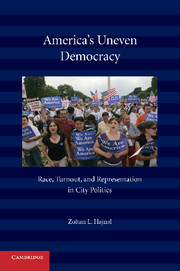Book contents
- Frontmatter
- Contents
- Acknowledgments
- America's Uneven Democracy
- Introduction
- 1 Where Turnout Should Matter
- 2 Turnout Could Matter at the Local Level
- 3 Winners and Losers in Mayoral Elections
- 4 Turnout and Representation on City Councils
- 5 Turnout and Local Government Spending Priorities
- 6 Raising Voter Turnout
- 7 The Broader Implications of Uneven Turnout
- Appendix
- Bibliography
- Index
1 - Where Turnout Should Matter
Published online by Cambridge University Press: 05 June 2012
- Frontmatter
- Contents
- Acknowledgments
- America's Uneven Democracy
- Introduction
- 1 Where Turnout Should Matter
- 2 Turnout Could Matter at the Local Level
- 3 Winners and Losers in Mayoral Elections
- 4 Turnout and Representation on City Councils
- 5 Turnout and Local Government Spending Priorities
- 6 Raising Voter Turnout
- 7 The Broader Implications of Uneven Turnout
- Appendix
- Bibliography
- Index
Summary
What do we know about voter turnout and its implications for American democracy? Despite an almost universal belief among political actors that turnout matters, analysis of existing empirical research provides little evidence to indicate that turnout is a critical factor in the American political arena. In fact, a rather extensive empirical literature strongly suggests that raising or lowering turnout would do little to change the face of American democracy. Higher or more even turnout would not produce new winners. With lower turnout, there are no big losers. As one scholar of American elections put it, “most electoral outcomes are not determined in any meaningful sense by turnout and are not likely to change through even highly implausible levels of voter mobilization. It appears that nonvoting does not as a rule make much of a difference to election outcomes” (Teixeira 1992:104).
How have empirical studies of the American electorate reached this conclusion? First, comparisons of the political preferences of voters to those of nonvoters indicates that the two groups have very similar preferences. Ray Wolfinger and Steve Rosenstone, two of the first political scientists to make this comparison found, for example, that “demographic biases do not translate into discernible overrepresentation of particular policy constituencies” (1980:109–111).
- Type
- Chapter
- Information
- America's Uneven DemocracyRace, Turnout, and Representation in City Politics, pp. 18 - 33Publisher: Cambridge University PressPrint publication year: 2009



